Today marks the 75th Anniversary of the sixth and final day of Operation Argument otherwise known as BIG WEEK. On Friday, February 25, 1944 the 8th Air Force returns to Messerschmitt factories in Regensburg preceded by 15th Air Force there. Other Messerschmitt fighter plants at Augsberg and Furth are also hit by 8th Air Force. These raids mark the conclusion of the first major operation in the final battle for air superiority before the Normandy invasion scheduled for June 1944.
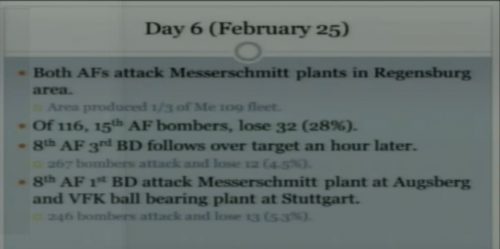
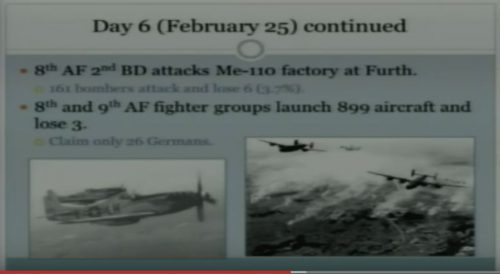
ETO Strategic Operations
Mission 235: In the final “Big Week” mission, 4 targets in Germany are hit; 31 bombers and 3 fighters are lost.
.
- 268 B-17s are dispatched to aviation industry targets at Augsburg and the industrial area at Stuttgart; 196 hit Augsburg and targets of opportunity and 50 hit Stuttgart; they claim 8-4-4 Luftwaffe aircraft; 13 B-17s are lost and 172 damaged; casualties are 12 WIA and 130 MIA.
- 267 of 290 B-17s hit aviation industry targets at Regensburg and targets of opportunity; they claim 13-1-7 Luftwaffe aircraft; 12 B-17s are lost, 1 damaged beyond repair and 82 damaged; casualties are 4 KIA, 12 WIA and 110 MIA.
- 172 of 196 B-24s hit aviation industry targets at Furth and targets of opportunity; they claim 2-2-2 Luftwaffe aircraft; 6 B-24s are lost, 2 damaged beyond repair and 44 damaged; casualties are 2 WIA and 61 MIA.
.
Escort is provided by 73 P-38s, 687 Eighth and Ninth Air Force P-47s and 139 Eighth and Ninth Air Force P-51s; the P-38s claim 1-2-0 Luftwaffe aircraft, 1 P-38 is damaged beyond repair; the P-47s claim 13-2-10 Luftwaffe aircraft, 1 P-47 is lost and 6 damaged, 1 pilot is MIA; the P-51s claim 12-0-3 Luftwaffe aircraft, 2 P-51s are lost and 1 damaged beyond repair, 2 pilots are MIA.
.
Mission 236: 5 of 5 B-17s drop 250 bundles of leaflets on Grenoble, Toulouse, Chartres, Caen and Raismes, France at 21292335 hours without loss
MTO Strategic Operations
.
Continuing coordinated attacks with the Eighth Air Force on European targets, B-17s with fighter escorts pound Regensburg aircraft factory; enemy fighter opposition is heavy. Other B-17s hit the air depot at Klagenfurt, Austria and the dock area at Pola, Italy. B-24s attack Fiume, Italy marshaling yard and port and hit Zell-am-See, Austria railroad and Graz airfield and the port area at Zara, Yugoslavia; 30+ US aircraft are lost; they claim 90+ fighters shot down.
.
For extensive background, see this Wikipedia article, where the passage above came from:
.
https://en.wikipedia.org/wiki/Big_Week
.
From Pickle Barrel’s to Radar Pattern Bombing of Cities
.
In evaluating the WW2 Combined Bomber Campaign in Europe there is far more propaganda about “precision bombing” than actual accurate and precise bombing. When using the Norden bombsite in test conditions, on a clear and still day, with an absolutely distinct against back ground target, with a picked high skill aircrew, from less than 10,000 feet altitude, you could get within a few hundred feet of the target.
.
Things were far less then perfect in combat over Europe. Bombing altitudes exceeded 20,000 feet and the number of days where cloud cover measured less than 4/10ths were few and concentrated in the summer.
.
“Big Week” was fought in European winter. Too fight then, the USAAF had to resort to the use of both British provided “H2S” 10 cm and hand built American “H2X” 3 cm wavelength radars carried on pathfinder bombers leading the USAAF bomber streams.
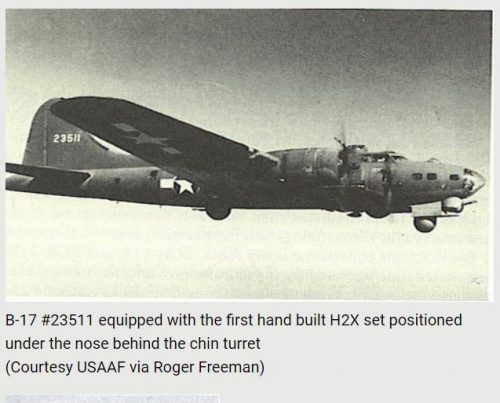
.
The figure below shows the accuracy difference between a Norden bomb site (300 yards) in perfect conditions and various radar and radio beacon systems (OBOE) with similar test perfection.
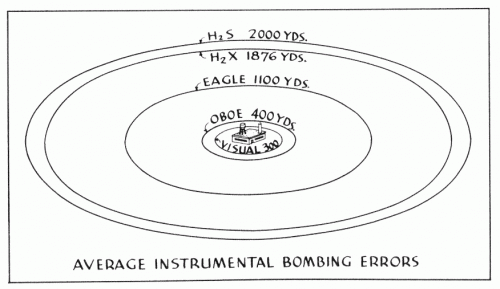
Because of the above, AAF stopped using the radial measurement of so many yards from an aim point landing near the target, to the measurement of “Landing in the Target Area.” The “Target Area” was defined as a circle with a 1,000 foot radius.
.
To put this “Target Area” into perspective, if we measure the area of a circle with 3.14 times the radius of the circle squared, the area of the circle contains 3,140,000 square feet.
.
By comparison, a football field, excluding the two end zones, contains 48,000 square feet. So the USAAF “Standard Target Area” could hold sixty-five football fields. If you are not an American football fan, this area is equal to over seventy-two acres (twenty-nine hectares in metric measurement).
In terms of the “pickle barrel” openings (seven square feet) of USAAF’s propaganda fame, this 1000 food circle fits 448,571 of them.**
.[From a forthcoming book about the myth of strategic bombing by Pierre M. Sprey and James Perry Stevenson.]
How the 8th Air Force Started Drawing REALLY BIG TARGET CIRCLES
.
The 8th AF bombing accuracy subsection drew 500 foot, 1,000 foot and 2,000 foot circles in the period of Dec 1943 to Feb 1943 in order to plot combat box formation bomb falls from bomber automatic camera footage and RAF post strike recon photos.
.
In this period then Colonel LeMay was pioneering multi-level combat boxes and “drop on lead bomber” tactics.
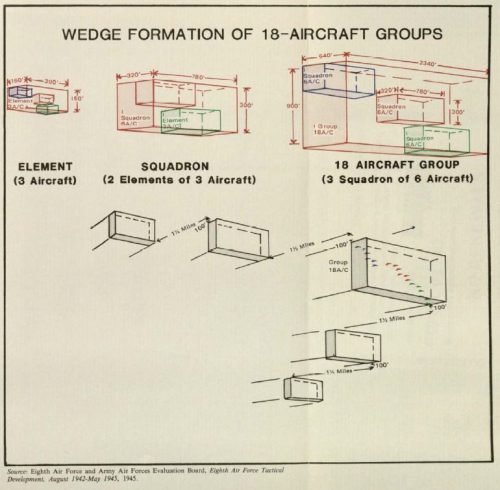
.
All of the above lead to a March 1943 report titled “Average of Dropping on the Leader Over Sighted Individually for Range When Bombing in Formation” which came out with several recommendations regards dropping on the lead in each combat box, aiming for the “best fit” of the formation bomb pattern, and doing everything possible to make a bomb patterns shorter.
.
This also resulted in the invention of the term “Mean Point of Impact” (MPI) for the targeting of large formations of bombers.
.
In April 1943 the 8th AF Bombing Accuracy Sub-Section wrote a report summarizing all of the above for General “Hap” Arnold and his senior staff in Washington DC.
.
On 1 May 1943 General Longfellow, who commanded VIIIth Bomber Command under Eaker at the time, made the number of bombs within 1,000 feet and 2,000 feet as the standard of accuracy all groups would be measured against for in reports to him. Word then spread to the wings and groups and soon everyone wanted similar bomb drop reports.**
.
[**The above summarizes pages 30 through 35, plus pages 58 to 64, of Charles McArthur’s “Operational Analysis in the U.S. Army Eighth Air Force in WWII.”]
Bad Weather, Radar, and 8th Air Force Bombing Productivity
There were a whole lot of reasons for drawing such big circles. They were called “bad weather days.” From Jan – May 1943 there were only 34 days of good visual bombing weather over Europe. In other words, there were only about seven days a month with “good bombing with the Norden bomb site” weather (defined as less than 4/10th cloud cover) over Europe, weighted towards the period of April-May 1943. This defined the need for Radar in order to bomb on days where the optical-only Norden bombsite was useless. The table below reflects what the introduction of radar pathfinders meant for the total number of 8th Air Force bombing days. The yellow bar in the table below includes “Big Week.”
.
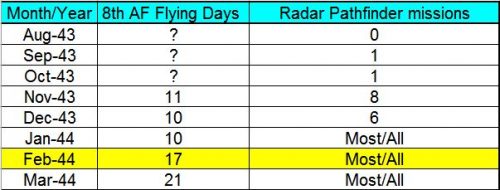
The introduction of radar bombing after the second Schweinfurt raid in October 1943 was the defacto abandonment of “Precision bombing” in favor of area bombing. The 8th Air Force would use the Norden bomb site if there was a break in the clouds of a primary or secondary target. But if that didn’t happen, the nearest German city of 500,000 plus souls — which was the smallest that an H2X radar could see — would get bombed in the center of the largest radar return.
.
This is what that USAAF radar bombing accuracy looked like:
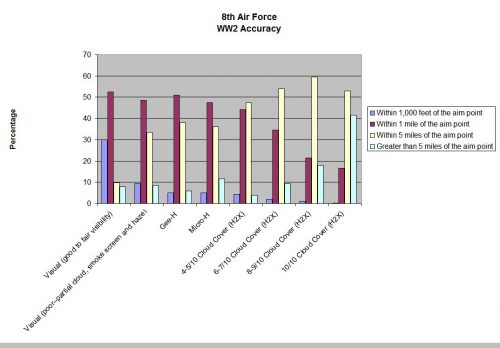
.

Like with the P-51 Narrative, as opposed to the P-47D reality, the “Precision bombing” of “Big Week” was anything but. If anything, the USAAF was less accurate with radar bombing in daylight that the RAF Bomber Command was at night in February 1944 because every RAF heavy bomber had a radar and months of training in their use.
,
You won’t find these facts in the WW2 USAAF Bomber General “Precision bombing” narrative, but it’s still the historical fact of how they beat the Luftwaffe during “Big Week”.
.
-End-
Things were far less then perfect in combat over Europe. Bombing altitudes exceeded 20,000 feet and the number of days where cloud cover measured less than 4/10ths were few and concentrated in the summer.
I think “precision bombing” pretty quickly morphed into the lead bombardier dropping as signal to all in the formation to do the same.
1) Precision guided bombing, whether using GPS, ground or plane-based laser, TV or even inertial guidance have improved bomb accuracy by more than one hundred fold (from within 5,000 feet on an average weather day to within 35 feet in all but the worst weather). A guided bomb’s total cost is about $10,000 each, last I read, where a dumb bomb’s cost is about $1,000. But that one hundred-fold improvement in accuracy means that one bomb at a cost of $10,000 can be used to do the same job that 100 bombs at a cost of $100,000 would have been needed to do, not counting needing several large bombers instead of a single fighter bomber. Now the Air Force actually can do what they set out to do in WW II.
2) Many times in Curtis LeMay’s career he developed and implemented tactics that were counter-intuitive and contrary to the doctrine at the time – and worked better than what the Air Force had been doing.
>>Now the Air Force actually can do what they set out to do in WW II.
The USAF continues to over sell what airpower can do.
The gap is simply a whole lot smaller now than 75 years ago.
>>Many times in Curtis LeMay’s career he developed and implemented tactics that were counter-intuitive and contrary to the doctrine at the time – and worked better than what the Air Force had been doing.
LeMay had a level of _Moral_, as opposed to physical courage lacking in today’s military officers.
His abandonment of turreted machine guns and the daylight, high altitude & close order defensive bomber formations he pioneered in Europe was 180 degrees outside the paradigm of how to use a B-29.
That took a great deal of real moral courage which is seldom appreciated nor rewarded.